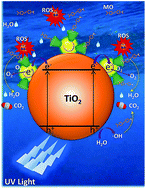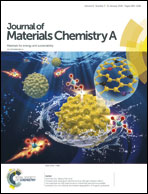Cyclodextrin–gold nanocluster decorated TiO2 enhances photocatalytic decomposition of organic pollutants†
Abstract
Titanium dioxide (TiO2) for various environmental applications has become a promising choice due to its high efficiency in the photocatalytic decomposition of organic pollutants. The drive for exploring various forms of TiO2 towards this goal has been influenced by its low cost and high photostability. There has been a recent surge of interest in developing various TiO2-based hybrid materials for enhanced photocatalytic performance. Here we introduce one such hybrid material, consisting of TiO2 nanoparticles (NPs) and per-6-thio-β-cyclodextrin (SH-β-CD) protected gold nanoclusters (Au NCs). Leveraging the complementary properties of TiO2 NPs, Au NCs, and the reactive SH-β-CD surface, the as-designed hybrid material showed improved photocatalytic performance over TiO2 NPs. Considering the fact that traditional thiolate ligands on the Au NC surface would create a physical barrier in photocatalytic reactions, SH-β-CD was chosen as the thiolate ligand for the synthesis of Au NCs, building upon its unique host–guest chemistry towards target organic pollutants. Indeed, the synergy created between the Au core and TiO2 NPs, as well as the SH-β-CD ligands (with a hydrophobic cavity, which could effectively capture and absorb organic targets via host–guest interaction) showed boosting effects on the photocatalytic decomposition of organic pollutants, such as methyl orange (MO) (e.g., under similar experimental conditions, the degradation efficiency of pure TiO2 was ∼47%, while for the hybrid TiO2, this value was ∼98%).



 Please wait while we load your content...
Please wait while we load your content...